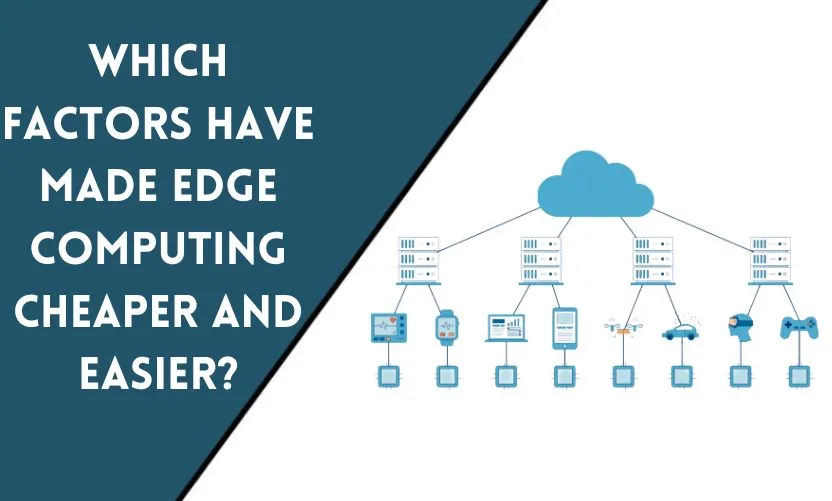
In recent years, edge computing has emerged as a popular computing paradigm that has transformed the way we think about the cloud. The rise of the Internet of Things (IoT), artificial intelligence (AI), and the need for faster and more reliable connectivity have led to the rapid growth of edge computing. This technology has been gaining traction because it offers faster and more reliable processing of data by moving computing power closer to the devices and sensors generating the data. Edge computing has become cheaper and easier due to various factors. In this article, we will explore these factors and how they have contributed to the evolution of edge computing.
Introduction
In the era of digital transformation, data processing and storage have become a crucial aspect of modern businesses. The traditional cloud computing model has limitations when it comes to processing and storing data. This is where the edge computing comes in handy. Edge computing allows businesses to process data locally, which reduces latency and improves performance.
Definition of Edge Computing
Edge computing is a distributed computing model that brings computation and data storage closer to the devices where it’s being generated. Edge computing devices are located at the edge of the network, closer to the source of data. This technology helps reduce the amount of data that needs to be transferred to the cloud, which in turn reduces latency and improves the overall performance of applications.
Importance of Edge Computing
Edge computing has several benefits, including reduced latency, improved security, and reduced network congestion. This technology is particularly important in industries where real-time processing is crucial, such as manufacturing, healthcare, and transportation. Edge computing also enables the development of new and innovative applications, such as self-driving cars and smart homes.
How Edge Computing Works
Edge computing works by placing computing power closer to the source of data. This reduces the amount of data that needs to be transferred to the cloud, which reduces latency and improves performance. Edge computing devices are typically small and lightweight, with low power consumption. These devices are equipped with sensors, processors, and storage, which allows them to process and store data locally.
Factors that have made Edge Computing Cheaper and Easier
Several factors have contributed to the evolution of edge computing and have made it cheaper and easier to implement.
Advances in Hardware
Advances in hardware have played a significant role in making edge computing cheaper and easier. The development of small and lightweight devices with low power consumption has made it possible to deploy edge computing solutions in a cost-effective manner. In addition, the cost of sensors, processors, and storage has decreased, making it more affordable for businesses to implement edge computing solutions.
Cloud Computing
Cloud computing has also played a role in making edge computing cheaper and easier. Edge computing solutions can be integrated with cloud-based solutions, which allows for greater flexibility and scalability. In addition, cloud providers are now offering edge computing services, which makes it easier for businesses to deploy edge computing solutions.
5G Technology
The emergence of 5G technology has also contributed to the growth of edge computing. 5G technology offers faster and more reliable connectivity, which enables real-time processing of data. This makes it possible to implement edge computing solutions that were not feasible with previous generations of wireless technology.
Standardization
The standardization of edge computing has also contributed to its growth. The development of standards and best practices for edge computing has made it easier for businesses to implement this technology. The standardization of edge computing has also made it easier for developers to create applications that can run on multiple edge computing platforms.
Challenges of Edge Computing
While edge computing has many benefits, there are also challenges associated with this technology. One of the biggest challenges is managing the large number of edge devices. As the number of edge devices increases, managing them becomes more difficult. In addition, security is a major concern in edge computing. Edge devices are often located in remote locations, making them more vulnerable to attacks.
Conclusion
In conclusion, edge computing has become cheaper and easier to implement due to various factors such as advances in hardware, cloud computing, 5G technology, and standardization. This technology offers several benefits, including reduced latency, improved security, and reduced network congestion. However, there are also challenges associated with this technology, such as managing a large number of edge devices and ensuring security.
Frequently Asked Questions
What is edge computing?
Edge computing is a distributed computing model that brings computation and data storage closer to the devices where it’s being generated.
What are the benefits of edge computing?
The benefits of edge computing include reduced latency, improved security, and reduced network congestion.
What factors have made edge computing cheaper and easier?
Advances in hardware, cloud computing, 5G technology, and standardization have made edge computing cheaper and easier to implement.
What are the challenges associated with edge computing?
The challenges associated with edge computing include managing a large number of edge devices and ensuring security.
How does edge computing work?
Edge computing works by placing computing power closer to the source of data, reducing the amount of data that needs to be transferred to the cloud and improving performance.










